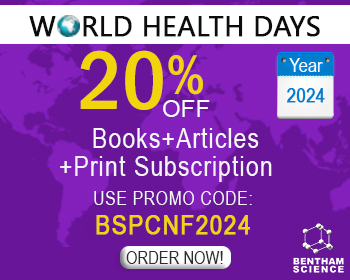Abstract
Natural Products (NP), specifically from medicinal plants or herbs, have been extensively utilized to analyze the fundamental mechanisms of ultimate natural sciences as well as therapeutics. Isolation of secondary metabolites from these sources and their respective biological properties, along with their lower toxicities and cost-effectiveness, make them a significant research focus for drug discovery. In recent times, there has been a considerable focus on isolating new chemical entities from natural flora to meet the immense demand for kinase modulators, and also to overcome major unmet medical challenges in relation to signal transduction pathways. The signal transduction systems are amongst the foremost pathways involved in the maintenance of life and protein kinases play an imperative part in these signaling pathways. It is important to find a kinase inhibitor, as it can be used not only to study cell biology but can also be used as a drug candidate for cancer and metabolic disorders. A number of plant extracts and their isolated secondary metabolites such as flavonoids, phenolics, terpenoids, and alkaloids have exhibited activities against various kinases. In the current review, we have presented a brief overview of some important classes of plant secondary metabolites as kinase modulators. Moreover, a number of phytocompounds with kinase inhibition potential, isolated from different plant species, are also discussed.
Keywords: Medicinal plants, Secondary metabolites, Crude extracts, Natural products, Kinases, Phytocompounds.
[http://dx.doi.org/10.1038/nrd4510] [PMID: 25614221]
[http://dx.doi.org/10.1016/j.drudis.2015.01.009] [PMID: 25617672]
[http://dx.doi.org/10.1021/acs.jnatprod.5b01055] [PMID: 26852623]
[http://dx.doi.org/10.1016/j.cell.2015.11.031] [PMID: 26638061]
[http://dx.doi.org/10.1021/np040106y] [PMID: 15620274]
[http://dx.doi.org/10.1039/c2np00097k] [PMID: 22231144]
[http://dx.doi.org/10.1126/science.1075762] [PMID: 12471243]
[PMID: 13221602]
[http://dx.doi.org/10.1073/pnas.77.3.1311] [PMID: 6246487]
[http://dx.doi.org/10.1016/0092-8674(80)90327-X] [PMID: 6251974]
[http://dx.doi.org/10.1021/ar0201207] [PMID: 12809533]
[http://dx.doi.org/10.3390/ph12010004] [PMID: 30609679]
[http://dx.doi.org/10.3389/fphar.2019.01295] [PMID: 31749703]
[http://dx.doi.org/10.1002/ptr.6551] [PMID: 31752046]
[http://dx.doi.org/10.3390/nu11102376] [PMID: 31590362]
[http://dx.doi.org/10.1002/ptr.6107] [PMID: 29732634]
[http://dx.doi.org/10.1002/ptr.6252] [PMID: 30637820]
[http://dx.doi.org/10.1038/sj.bjp.0702879] [PMID: 10556937]
[PMID: 11121513]
[PMID: 3106339]
[http://dx.doi.org/10.3390/ijms17040569] [PMID: 27092490]
[http://dx.doi.org/10.1111/j.1432-1033.1983.tb07692.x] [PMID: 6311542]
[http://dx.doi.org/10.1016/0006-2952(82)90028-4] [PMID: 6284174]
[http://dx.doi.org/10.1016/0006-291X(92)90792-J] [PMID: 1323287]
[PMID: 7085651]
[http://dx.doi.org/10.1073/pnas.80.1.36] [PMID: 6296873]
[http://dx.doi.org/10.2174/18715206113139990119] [PMID: 23272913]
[http://dx.doi.org/10.1093/carcin/bgt316] [PMID: 24067903]
[http://dx.doi.org/10.18632/oncotarget.5157] [PMID: 26435478]
[http://dx.doi.org/10.3390/ijms19061664] [PMID: 29874795]
[http://dx.doi.org/10.3390/ijms17101681] [PMID: 27735841]
[http://dx.doi.org/10.3892/or.2018.6312] [PMID: 29565448]
[http://dx.doi.org/10.7150/ijms.20336] [PMID: 28924370]
[http://dx.doi.org/10.1016/j.biopha.2017.02.061] [PMID: 28258039]
[http://dx.doi.org/10.3892/ijmm.2018.3654] [PMID: 29749427]
[http://dx.doi.org/10.1016/j.biopha.2016.08.035] [PMID: 27551764]
[http://dx.doi.org/10.1007/s13277-016-4864-x] [PMID: 26797785]
[http://dx.doi.org/10.1002/jcb.25729] [PMID: 27606834]
[http://dx.doi.org/10.1016/j.yexcr.2016.01.006] [PMID: 26826337]
[http://dx.doi.org/10.3892/ol.2018.8541] [PMID: 29805688]
[http://dx.doi.org/10.1016/j.ejphar.2018.05.027] [PMID: 29782854]
[http://dx.doi.org/10.3892/ijo.2018.4375] [PMID: 29693152]
[http://dx.doi.org/10.3892/or.2017.5709] [PMID: 28627607]
[http://dx.doi.org/10.18632/oncotarget.15535] [PMID: 28423510]
[http://dx.doi.org/10.1021/jm701501x] [PMID: 18610999]
[http://dx.doi.org/10.1002/mc.22718] [PMID: 28833603]
[http://dx.doi.org/10.1158/1940-6207.CAPR-11-0397] [PMID: 22805054]
[http://dx.doi.org/10.18632/oncotarget.15584] [PMID: 28423582]
[http://dx.doi.org/10.1007/s10529-016-2102-7] [PMID: 27099069]
[http://dx.doi.org/10.1021/ol016775+] [PMID: 11735581]
[http://dx.doi.org/10.1021/np010428r] [PMID: 11809076]
[http://dx.doi.org/10.1016/j.ejphar.2009.03.071] [PMID: 19356729]
[http://dx.doi.org/10.1002/ptr.6419] [PMID: 31359516]
[PMID: 27356682]
[http://dx.doi.org/10.3390/molecules20022728] [PMID: 25665066]
[http://dx.doi.org/10.1002/jcp.26620] [PMID: 29693253]
[http://dx.doi.org/10.2174/1570161116666180209113014] [PMID: 29424316]
[http://dx.doi.org/10.1016/0167-4889(94)90299-2] [PMID: 7803521]
[http://dx.doi.org/10.1186/s12906-019-2702-6] [PMID: 31647008]
[http://dx.doi.org/10.3390/molecules24224179] [PMID: 31752145]
[http://dx.doi.org/10.1093/carcin/bgn282] [PMID: 19073879]
[http://dx.doi.org/10.3109/14756366.2015.1022173] [PMID: 25798688]
[http://dx.doi.org/10.2337/db06-0006] [PMID: 16873688]
[http://dx.doi.org/10.1002/ptr.6206] [PMID: 30346043]
[http://dx.doi.org/10.1002/ptr.6217] [PMID: 30402951]
[http://dx.doi.org/10.1021/jm00038a003] [PMID: 8021914]
[http://dx.doi.org/10.1006/abbi.1999.1145] [PMID: 10222035]
[http://dx.doi.org/10.3390/molecules23040719] [PMID: 29561817]
[http://dx.doi.org/10.4103/pm.pm_35_19]
[http://dx.doi.org/10.1158/0008-5472.CAN-04-3640] [PMID: 15833867]
[http://dx.doi.org/10.1016/0014-5793(93)80085-9] [PMID: 8458434]
[http://dx.doi.org/10.1021/np049616i] [PMID: 16038553]
[http://dx.doi.org/10.1248/bpb.b15-00835] [PMID: 26983907]
[http://dx.doi.org/10.1016/j.compbiomed.2013.02.020] [PMID: 23668355]
[http://dx.doi.org/10.1016/j.fitote.2012.06.002] [PMID: 22698713]
[http://dx.doi.org/10.1016/j.jep.2010.09.021] [PMID: 20883766]
[http://dx.doi.org/10.1016/j.biopha.2018.02.011] [PMID: 29432993]
[http://dx.doi.org/10.1080/10717544.2017.1386729] [PMID: 29019267]
[http://dx.doi.org/10.3892/or.2016.4735] [PMID: 27108927]
[http://dx.doi.org/10.5530/pj.2019.11.89]
[http://dx.doi.org/10.1016/j.jep.2019.112179] [PMID: 31445130]
[http://dx.doi.org/10.1016/j.biopha.2019.109297] [PMID: 31404771]
[http://dx.doi.org/10.3390/molecules18033018] [PMID: 23467012]
[http://dx.doi.org/10.1021/np400856h] [PMID: 24798019]
[http://dx.doi.org/10.1080/09540105.2019.1638889]
[http://dx.doi.org/10.1016/j.phytochem.2009.11.008] [PMID: 20022347]
[http://dx.doi.org/10.3923/pjbs.2019.502.509] [PMID: 31930840]
[http://dx.doi.org/10.1016/j.bcp.2008.12.013] [PMID: 19161987]
[http://dx.doi.org/10.2174/138945010790711950] [PMID: 20210754]
[http://dx.doi.org/10.1039/b923848b] [PMID: 20336234]


























